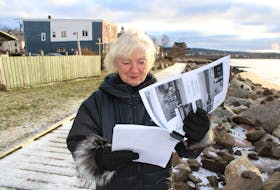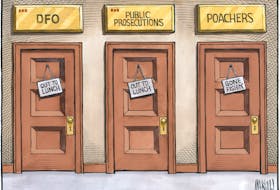Justice Joshua Arnold spent much of the day Wednesday delivering instructions to the jury in the trial of Christopher Garnier at the Supreme Court of Nova Scotia prior to them starting deliberations.
Arnold reminded jurors that justice will not be done if they wrongly apply the law. He also reminded them to apply the law using only the evidence seen and heard in court and from no outside source. Arnold told jurors to talk and listen to each other and not agree simply for the sake of a unanimous verdict.
Garnier’s charges are in relation to the death of Catherine Campbell, who was employed as a Truro police officer. She had grown up in Stellarton and was formerly a volunteer firefighter. The defence has argued that she died accidentally while the pair were engaged in rough sexual activities, while the Crown has argued that Garnier deliberately strangled her and discarded her body.
"Christopher Garnier does not have to prove that he is not guilty of the offences charged," said Arnold. He added that jurors can only find Garnier guilty of second-degree murder if the Crown can prove its case beyond any reasonable doubt. Arnold also provided instructions on how to deliberate on the second charge of interfering with a dead body.
Arnold advised jurors that they should consider remarks made by Garnier even if they feel unsure about them.
Regarding the charge of interfering with human remains, Garnier claimed he was in a state of automatism or not fully conscious of his actions. The justice said such acts can only be punished if performed voluntarily. This means evidence must be presented by a defendant to show they were in such a state at the time of an alleged offence.
"It is for that person to satisfy you on a balance of probabilities," said Arnold.
He further reminded jurors that claims can be faked and not to be taken in by experts. However, if a state of automatism is proved, then the person must be cleared of the charged.
"You must not make the evidence conform to the result you think is appropriate," said Arnold.
The judge also went over the evidence presented by witnesses in the trial, including Garnier's own answers to police in his interview, evidence presented by the chief medical examiner and the blood spatters found in the apartment on McCully Street.
Arnold said the jury must consider whether Garnier intended to cause harm to Campbell, if she consented to him using physical force including slaps and choking as he told in his version of events.
Arnold mentioned the third element of an unlawful act, the first two being the intentional application of force and that bodily harm was caused. The third is consent.
Garnier says that Campbell consented (or he honestly believed that she did). It is up to the jury to examine all of the circumstances in making a decision. Arnold said that the principle of reasonable doubt applies when weighing the evidence.
The next question is if Garnier had the state of mind required for murder, meaning that he meant to kill her or cause bodily harm that was likely to kill her and proceeded despite his knowledge that she would likely die as a result. Only one state of mind must be proven to find a person guilty of murder.
Arnold again recounted Garnier's testimony to police when he said that he did not know what he was thinking or feeling at the time of Campbell's death.
Regarding her remains, the Crown must prove that he interfered with her remains in a way that was disrespectful and offensive. They must also prove that he intended to do so.
Jurors were given a verdict sheet with a choice of possible rulings as well as a decision tree which offers questions to help jurors reach a verdict on both charges.
Two members of the jury were chosen at random to be dismissed leaving a jury of seven women and five men to make the final decision.








